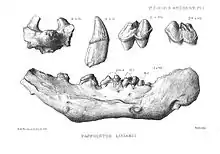Pappocetus
Pappocetus is an extinct protocetid cetacean known from the Eocene of Nigeria and Togo.[1]
| Pappocetus Temporal range: Late Eocene, } | |
|---|---|
 | |
| Pappocetus lugardi specimens from Andrews 1919 | |
| Scientific classification | |
| Domain: | Eukaryota |
| Kingdom: | Animalia |
| Phylum: | Chordata |
| Class: | Mammalia |
| Order: | Artiodactyla |
| Infraorder: | Cetacea |
| Family: | †Protocetidae |
| Subfamily: | †Georgiacetinae |
| Genus: | †Pappocetus Andrews 1919 |
| Species | |
| |
The type specimen BMNH M11414 an incomplete left mandible with symphysis, a deciduous premolar, and unerupted molars.[2] It was found in Bartonian (40.4 to 37.2 million years ago) layers of the Ameki Formation (6.0°N 7.0°E, paleocoordinates 1.8°N 1.7°E)[3] in southern Nigeria.[2][4]
The specimen M11086 is a left mandibular ramus broken in three pieces with sockets for canines and incisors and the front part of a single-rooted P1. Andrews, to whom the two specimens were brought separately, noted that they "to some extent supplement one another, so that the structure is fairly clear" and thus estimated the size and morphology of the missing parts by comparing the specimens to each other.[5]
Pappocetus differs from all other known protocetid genera by the step-like notch on the ventral margin of the mandible below M2 and M3; from Indocetus and Rodhocetus by the deciduous double-rooted P1; from Protocetus and Babiacetus by the presence of accessory cuspules; and from Babiacetus by the unfused symphysis terminating just before P3. Its molar morphology is similar to Georgiacetus and its estimated body size to that of Eocetus.[2]
The species is named after Sir Frederick Lugard who sent one of the specimens to Andrews.
Notes
- Pappocetus in the Paleobiology Database. Retrieved April 2013.
- Williams 1998, pp. 11–12
- Port Harcourt RR in the Paleobiology Database. Retrieved April 2013.
- Pappocetus lugardi in the Paleobiology Database. Retrieved April 2013.
- Andrews 1919, p. 309
References
- Andrews, C. W. (1919). "A description of new species of zeuglodont and of leathery turtle from the Eocene of Southern Nigeria". Proceedings of the Zoological Society of London. 18 (3–4): 309–19. doi:10.1111/j.1096-3642.1919.tb02124.x. OCLC 228169273. Retrieved 22 April 2013.
- Williams, Ellen M. (1998). "Synopsis of the Earliest Cetaceans". In Thewissen, J. G. M. (ed.). The Emergence of Whales. Advances in vertebrate paleobiology. New York: Plenum Press. ISBN 9780306458538. OCLC 300450327. Retrieved 22 April 2013.